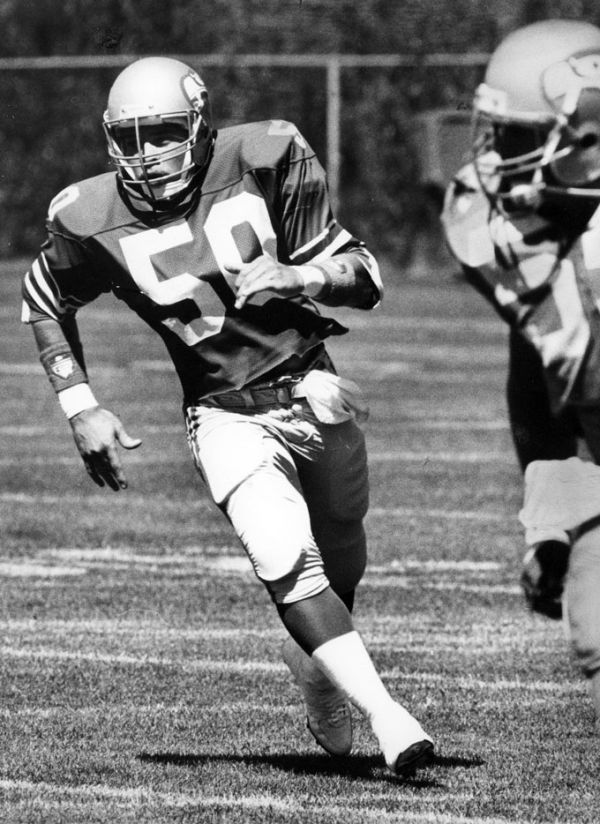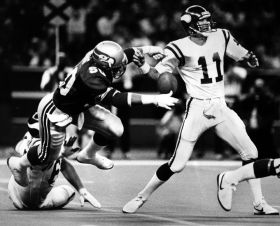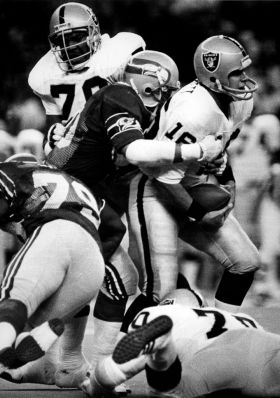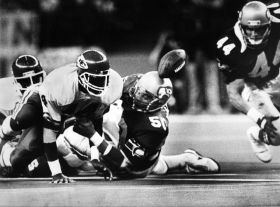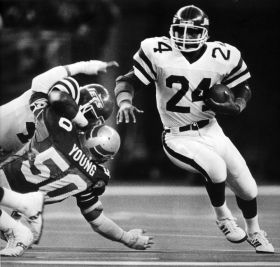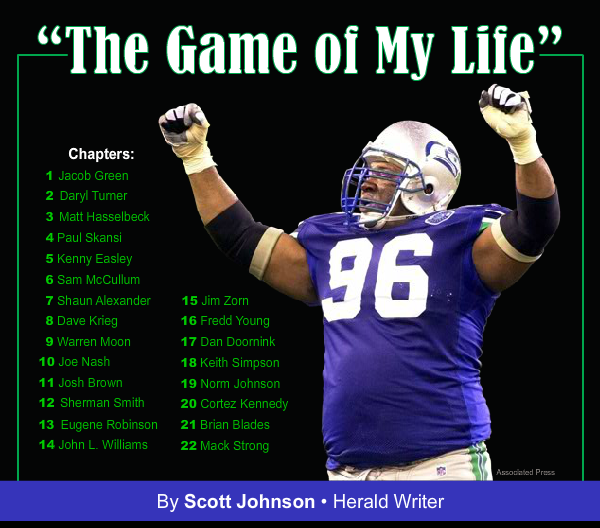On a winter afternoon in February 2008, Fredd Young willingly took off the mask. The former NFL player was surrounded by dozens of others, many of whom saw him as a tough guy who never showed pain. Even though he walked with the slight limp of a man who had undergone seven hip surgeries, Fredd Young wasn't the kind of person to give off even the slightest hint of weakness.
And yet on that afternoon, with eyes measuring his every move, Young unabashedly wept without any concern for his reputation.
Freddy Young Jr. had just signed his name to a national letter of intent, meaning Fredd Young's eldest son would play college football – just like his dad. Never mind that Frederick Jr. had spurned Fredd's college choice of New Mexico State and decided to attend the University of New Mexico; the elder Young was as proud as a father could be.
"It touched me when he was signing," Fredd Young said 24 hours later. "He's his own man. I didn't push him. I didn't even talk to him about (which school to choose). He actually said something to me, somewhat jokingly. He said that because I'm in (New Mexico State's) Ring of Honor, and I'm kind of a legend there, he's going to make his own legend down in Albuquerque."
Freddy Young could have tried to follow in his father's footsteps, but he made a wise move in choosing his own path. As Seattle Seahawks fans know all too well, there is only one Fredd Young.
Fredd Young first jumped on to the football radar during his senior season at Woodrow Wilson High School in Dallas, but it wasn't until a couple years later that he really made a name for himself. Or, more accurately, Britt Mayberry made the name for him.
Mayberry, a little-known backup linebacker on the New Mexico State football team, was the person who suggested that Frederick Kimball Young change the spelling of his shortened first name. Mayberry told his teammate, Fred Young, that he should add a second 'D' to his name because he hit so hard it made opposing players stutter.
And so Fred Young became Fredd Young.
It was a name that Seattle Seahawks fans won't soon forget. In just four seasons with the team, Young left quite a stack of memories. He went to four Pro Bowls with the team and emerged as one of the hardest-hitting tacklers even before he broke the starting lineup late in his rookie year. Just like he did to opposing players, Young made quite an impact during his time in Seattle.
Not that his high school career gave any hints of future stardom. A self-described "late bloomer," Young spent most of his fall Fridays playing in the shadows of others at Wilson High. As a 16-year-old senior – his November birthday came after the football season – Young was an undersized, first-year starter who didn't even dare dream of playing football in college. The 180-pound defensive end/linebacker had already planned out a future that involved training to become an Air Force pilot, but fate eventually intervened.
During a typical Friday night at Wilson High, several college recruiters were on hand to watch a teammate named Aaron Bolton, a 6-foot-6 lineman. By the end of the evening, several of them were talking about the undersized linebacker who was in on just about every play.
"I had the game of my life," Young recalled. "I had a couple of interceptions and about 20 tackles."
New Mexico State and North Texas in nearby Denton were the only schools to offer full rides, and Fred Young – this was still before the double-D – opted to get away from his hometown of Dallas.
Living in the city of Las Cruces, N.M., was an adjustment for Young, but the jump to college football was an almost seamless transition. Young developed a reputation for making big hits, and it soon became apparent that he was the best athlete on the NMSU football team. He started at linebacker, played on coverage teams and even returned kicks and punts. Young led the Missouri Valley Conference (MVC) in punt return average (12.2 yards per return) and returned two kickoffs for touchdowns. He also had 400 tackles during his four-year career and 12 sacks as a senior.
Even though Young played in the obscurity of the MVC, he made enough of an impression on NFL scouts that the Seahawks used a third-round pick on him in the 1984 draft. Seattle already had a solid linebacking corps made up of starters Bruce Scholtz, Shelton Robinson, Keith Butler and Greg Gaines, but the Seahawks liked Young's potential and believed that he could provide help right away on special teams. No one expected Young to become an immediate playmaker, which is exactly what he did during the 1984 preseason. Young was so impressive during the exhibition games that he finished the preseason as a starter, only to lose that job when the real games began.
"(Seahawks defensive coordinator) Tom Catlin came to me and explained that Scholtz was the starter, and he can't really lose his position during the preseason," Young recalled. "That was a big surprise to me."
The news didn't sit well with Young, who believed that he had done enough to be one of the two starting outside linebackers in Seattle's 3-4 defensive scheme. Rather than complain about his status, Young went out to try to prove himself all over again. He did it the only way he knew how: by making an impact.
"I was used to starting," he recalled. "It was frustrating because I wasn't starting. I was always believing there was no one who could stop me, (that) no one could block me. Maybe I had a chip on my shoulder."
Fredd Young made such an impact in his first official NFL game that the Seahawks eventually had to make room for him with the starting defense. It was a game that set the tone for his NFL career and a game that Young himself will never forget.
Seahawks vs. Cleveland BrownsSeptember 3, 1984
as told by Fredd YoungThe game I remember the best might have been my first official game in the NFL. It was the 1984 regular-season opener, and we were playing the Cleveland Browns. I was all wide-eyed and fresh, kind of excited – overwhelmed, basically. I had started most of the preseason, but when the regular season began I was playing mostly special teams. I went out there and made a lot of tackles inside the 20 and blocked a punt, so I was doing my best to win the starting job back.
Fredd Young sacks the quarterback for a loss of 10 yards during a game for the Seahawks
[ The Herald ]In the preseason, I had been the leading tackler at outside linebacker. I thought I was going to continue to be the player who got to start and make all the plays. But for the first regular season game, defensive coordinator Tom Catlin came to me and said, 'We're going to let the guy who played the position last year play.' That guy's name was Bruce Scholtz. So I went right back to the bench on defense. But I was still playing special teams. It inspired me to run faster on special teams and try to do more with the time I had on the field.
I remember the first kickoff. I tackled Cleveland's return man inside the 15-yard line. I don't know how I got down there so fast. I just outran the blocking scheme that the Browns had. They weren't able to block me, so I had a free shot at the guy. It was at the Kingdome, and the crowd went wild. They all went, 'woo!' It just fired me up. Every time I went down there, I wanted to do that.
Later, I blocked a punt. That was something that we worked on a lot in practice. Rusty Tillman, our special teams coach, would actually have us walk through a blocked punt at practice and take the ball off the punter's foot. It was easy to say, but harder to do during the action of a game. I was pretty green, so I was just using my quickness to get back there and lay out. I blocked a lot of them over the years. I blocked one, in Buffalo, where the punter actually kicked me in the throat. I don't remember it vividly, but I read about it the next day. I was so excited I didn't even feel it.
But this one, in the Cleveland game, went off my hands. I remember getting off the ball real quick. I actually saw it on film later. We blocked the punt, and Paul Moyer fell on the ball, and I was trying to pick him up off the ground so he could run with it. He was making sure he fell on the ball, which was smart, but I was the kind of player who always wanted more.
It turned out that we didn't need the touchdown. We beat Cleveland 33-0. That was my first experience in an NFL game. I was pretty motivated after being told I wasn't going to start. I was thinking that they couldn't keep a man off the field if he's making the crowd cheer and forcing all these turnovers. So after that game, I went to Tom Catlin and said, 'What can I do to get on the field?'
By midseason, I guess it was predetermined that they were going to get me on the field in some way. So they put me at inside linebacker. And later that year I ended up taking Shelton Robinson's place as the starter. I studied his position for about a week. And they put me in there, and I made a lot of tackles. I think I made 10 tackles. That was my position from then on.
Fredd Young's first NFL game set the tone for what was to come. He continued to star on special teams, earning a spot in the Pro Bowl as a rookie. Young was a full-time starter the following year yet made the Pro Bowl as a special teamer again. In 1986 and '87, he went to the Pro Bowl as a linebacker.
In each of his three seasons as a Seahawks starter, Young led the team in tackles. He had 99 tackles and a career-high nine sacks in the strike-shortened, 15-game season in 1987. Young started 13 games that year, crossing the picket line along with a few high-profile teammates like Steve Largent. The Seahawks went 9-6, earning their first postseason appearance since 1984.
Young had 12 tackles and a forced fumble in the playoff game at Houston, but his afternoon was better remembered for the play that did not count. With the two teams deadlocked early in sudden-death overtime, Young made an apparent interception that looked like it would give the Seahawks possession of the ball deep in Houston territory. The officials ruled the pass incomplete, and even a rather convincing replay wasn't enough to overturn the call.
"But I caught it," Young said in 2008. "You just continue to play. And they went down and kicked the field goal and won."
That would amount to Young's final game in a Seahawk uniform. His future with the Seahawks was unsettled because of a messy contract situation and also because of a player known simply as The Boz.
Before that 1987 season, the Seahawks had won the rights to the No. 1 overall pick in the annual supplemental draft. The oft-overlooked supplemental draft was usually made up of players who had fallen through the cracks, but that year the draft included one of the most famous college football players of all time.
Brian Bosworth, who had become known as "The Boz" and sported the most famous haircut of any college football player, lost his college eligibility when he tested positive for steroids in 1987. His inclusion in the June supplemental draft led to a rare lottery, despite his storied past. The Seahawks won the rights to the No. 1 overall pick, and took the two-time winner of the Dick Butkus Award.
Years later, Young would recall that he was initially told the pick was made in order to trade Bosworth to another team. But the Seahawks eventually signed Bosworth to a 10-year, $11 million contract, the biggest deal ever for a rookie. And as the 1987 season went along, "The Boz" earned more and more playing time and eventually switched sides to take Young's job as the starting inside linebacker on the strong side.
"The guy who was playing next to me, Keith Butler, he was a way better player than Brian," Young said. "But you sign a guy for $11 million and no matter what, you have to play him. So they forced him into the lineup, probably a little too early. He had no clue what he was doing. He took the job of signal caller, and he had no clue. But he played the position."
With a unique haircut, a brash personality and never-ending publicity, "The Boz" had a much different path to the NFL than young. But Young, the team-first veteran, tried to take Bosworth under his wing.
"I took him with me to the places that I would frequent," Young recalled. "But it kind of got out of hand: 'Here comes The Boz. Oh, and the Seahawks defense.' That kind of got old.
"And he distanced himself from us. He thought he was all that. He started not talking to people. It was like, what's going on here?"
Twenty-one years later, Young would look back on Bosworth not with disdain but with gratefulness.
"Actually, I'm happy" about Bosworth's career, Young said. "I'm happy about what happened. Because of his contract, it helped a lot of players' contracts. He raised the bar for the linebackers in the league.
"Look at some of the linebackers of the day -- Mike Singletary, Wilber Marshall -- they all came to the table because of Boz."
After the 1987 season, Young was looking for a payout of his own. The Seahawks were on the verge of being sold, and Young later maintained that general manager Mike McCormack told him the team did not want to sign off on any more long-term contracts while the sale was being consummated. Young then asked to be traded, and the Seahawks honored his request.
Young negotiated with at least two teams before the trade was made. The San Francisco 49ers, a long-suffering franchise with a young coach named Bill Walsh, were offering a deal that would pay Young about $750,000 a year.
"Bill Walsh came to me and said, 'Don't worry about the contract; we're going to be in the playoffs and the Super Bowl. You'll make it up,'" Young recalled with regret in his voice. "I was like, 'Yeah, right.'"
Instead, Young reached an agreement with the Indianapolis Colts, whose contract averaged $1 million per season over five years. The Colts and Seahawks worked out a deal that would send Seattle two first-round picks, and the four-time Pro Bowler was on his way to a new city.
"The coaching staff was pushing me out," Young said of his career with the Seahawks. "Tom Catlin came to me and said they were going to let Boz play the max position and that I should learn the other side. I was all-pro at that position."
After turning in his finest season as a pro in 1987, Young saw his career take a downward turn with the Colts. Playing in a new system, Young had just two sacks over his first two years in Indianapolis. He entered the 1990 season as a 29-year old on the downside of his career. In the 11th game of that season, Young suffered a dislocated hip. The debilitating injury would end his seven-year career and eventually require several surgeries – two of them hip replacements – over the next 17 years.
"I've been broken down for a long time," he said in 2008. "…All those hits I took in Seattle and Indianapolis, they're all coming back to haunt me."
Because he invested his money wisely, Young was able to enjoy retirement without having to work. He moved back to Las Cruces, was enshrined in NMSU's athletic Hall of Fame, and got married twice, and had four children. His two older children went on to college in state. Two younger sons, Matthew and Monroe, were still in grade school as of 2008.
Freddy Young Jr. had a high school career similar to that of his father. Fredrick Jr. was a late bloomer who grew four inches, to 6-foot-1, during his senior year at Mayfield High School in Las Cruces. The University of New Mexico was after him early on, while NMSU joined the recruiting chase a few months later. Freddy Young, a defensive back who helped lead his team to three state titles, chose UNM. He officially signed the letter on Feb. 5, 2008, alongside a Mayfield teammate who was also headed to UNM.
Father Fredd Young, the tough guy who rarely showed pain, cried not because he was disappointed in his son's college choice but because he was overcome with parental joy.
"He made me real proud," Young said. "He was on the local news station and sounded real intelligent. He sounded like one of the announcers, using all these big words. He's an honor roll student, an A-student. So he made me proud."
Fredd's two youngest sons may also follow in their father's footsteps. As a 9-year old, Matthew was already weighing in at 160 pounds. In 2008, his younger brother was also a pretty big kid who was already showing the kind of toughness that Seahawks fans saw in his father.
Fredd Young had also become a grandfather after his daughter had a child with her husband, former NMSU basketball player Justin Hawkins.
"I am grateful for the ability that God gave me," he said. "I'm just happy to be where I was, to go from where I came from. I am content. I'm going to live through my sons' play right now."

